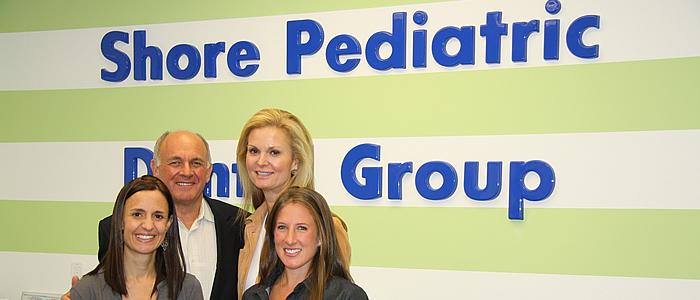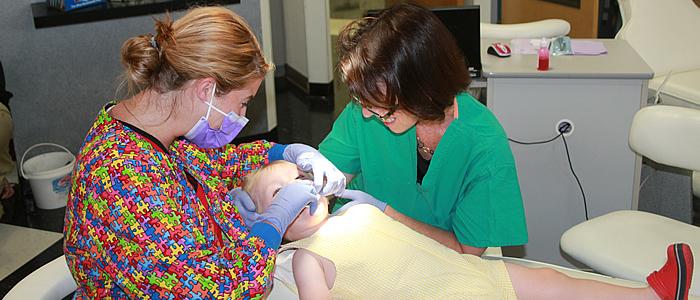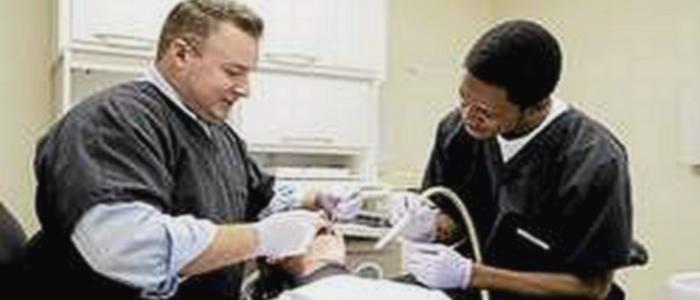
Dental
Most programs require two semesters of biology (some require an additional course or two in biology), four to five semesters of chemistry (starting with general chemistry and including organic and for a number of schools biochemistry), two semesters of physics, two semesters of English, and up to two semesters of math. Advanced courses can typically substitute for introductory-level courses, but check with the programs that you are interested in. At ºÚÁϳԹÏÍø, we recommend the following courses to meet those requirements.
Always check for specific course requirements for each school you are going to apply to—this is only a guide!
| Class | Semesters | ºÚÁϳԹÏÍø Course(s) | Notes |
|---|---|---|---|
| Chemistry | four semesters with lab typically required, including general and organic chemistry, and, increasingly, biochemistry | CH 125 or 126, CH 221, CH 222,& CH 341 with CH 342 highly recommended |
Must take placement diagnostic. Schools that require two semesters of general chemistry will typically count CH 341 as the second semester (CH 115 does not fulfill the requirement). A number of schools require four semesters of chemistry (often with labs) and a semester of biochemistry without lab. CH 342 is therefore highly recommended with CH 125 (or 126), CH 221, CH 222, and CH 341 in order to have 4 semesters of chemistry with labs on your transcript and a semester of biochemistry without lab. HPAC has a letter it can send to schools regarding the Chemistry curriculum at ºÚÁϳԹÏÍø, including the one-semester general chemistry. Please reach out to the individual programs to discuss their specific requirements. |
| General biology | two semesters with lab |
BI 107 & BI 108 |
Note- some schools may require additional biology courses (e.g., BI 246, BI 245, BI 244, or BI 247) |
| General physics | two semesters with lab* |
PY 130 (formerly 207) & PY 140 (formerly 208) |
*must take Calculus I and II to take physics at ºÚÁϳԹÏÍø; algebra-based physics would be sufficient |
| English | two semesters | ||
| Math | up to two semesters* | * Check with programs, as some require statistics, others calculus, and a number do not have a specific math requirement. Physics at ºÚÁϳԹÏÍø requires calculus. |
Note: some schools still require two semesters of calculus.
TESTS
The Dental Admission Test (DAT) is designed to measure general academic ability, comprehension of scientific information, and perceptual ability. Tests are administered year-round at Prometric Test Centers in the United States. You will need to obtain a DENTPIN before taking the DAT. Please plan to schedule your exam at least 60 to 90 days ahead of time. Official scores are reported electronically to the dental schools you select on your DAT application. Additionally, when you select dental schools on your DAT application that participate in a standardized application service, the Department of Testing Services will report your official scores to the application services. At the completion of your testing appointment, you will receive an unofficial score report at the Prometric Testing Center.
Doctor of Dental Surgery (DDS) or Doctor of Dental Medicine (DMD) degrees are accredited by the ADA's Commission on Dental Accreditation (CODA). Programs take four years to complete with additional years for dental specialties. Over 50 dental programs in the United States exist, and admission is competitive. Most U.S. schools accept a single online application through the American Association of Dental Schools Application Service (AADSAS). After completing the degree, students must pass National Board Dental Examinations (Part I and II) to practice in the U.S.
Frequently Asked Questions
Admissions requirements to the dental schools vary by school. It is important for pre-dental students to be aware of the specific requirements of the schools to which they apply. For more information, please go here.
To review program-specific requirements, please research your programs of interest at
"Schools seek to select applicants exhibiting evidence of high intellectual competence, demonstrated knowledge and interest in the profession, cultural sensitivity, and personal traits to relate compassionately to patients. Communication skills, leadership ability, good character, motivation, and knowledge of the field of dentistry are all evaluated by admissions committees.
The strength of academic preparation, as demonstrated by courses completed, grades earned, and DAT scores are important factors in admissions decisions. However, there are other factors. Many committees encourage the holistic review of applicants, considering factors such as challenges faced in pursuing a college education, improved performance, and successfully balancing academics, work, and extracurricular activities.
The best reference about dental school programs of study is the ADEA Official Guide to Dental Schools, which is updated annually and provides descriptive information and statistics from each of the U.S. and Canadian dental schools.(National Association of Advisors for the Health Professions, 2013)
According to the guide, the total mean GPA for the class entering dental school in the fall of 2012 ranged from 3.20 to 3.9. The total mean science GPA for the same class ranged from 3.11 to 4.0. The mean DAT scores ranged from 17 to 23.2 (academic average, or AA) and 17.9 to 22.2 (perceptual ability test, or PAT).
*The academic average is the average of five scores rounded to the nearest whole number: quantitative reasoning, reading comprehension, biology, general chemistry, and organic chemistry.
Applicants are strongly encouraged to apply early. The ADEA AADSAS application becomes available around June 1, for admission to the class starting in September of the following year. Dental schools begin receiving applications in late June, and generally begin interviews in August and September. Dental schools begin sending offers of acceptance starting December 1 and continue into July or up to two weeks before the start of dental school classes. (National Association of Advisors for the Health Professions, 2013)
ADEA is the American Dental Education Association.
AADSAS is the Associated American Dental Schools Application Service, the centralized
application service for most U.S. dental schools. ADEA AADSAS simplifies the application
process by allowing applicants to complete one standardized application, rather than
filling out multiple applications.
The ADEA Official Guide to Dental Schools answers virtually every question about dentistry and the dental school admission process. More information can be found at .
Please consult your HPAC advisor. If you would like to be assigned an HPAC advisor, please complete the HPAC Interest Form. After you submit, Ellen Grandy will be letting you know who your HPAC advisor is.
In addition, you may want to consider joining the Pre-Health Club or making an appointment with Rachel Chase in the Career Development Center by calling 518-580-5790 or stopping by their office in Starbuck, second floor.


